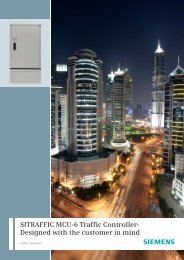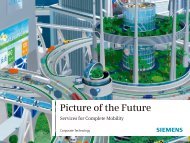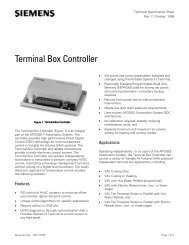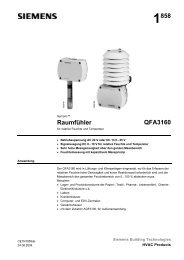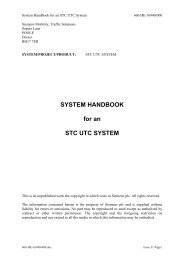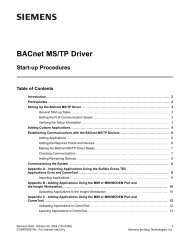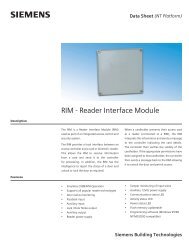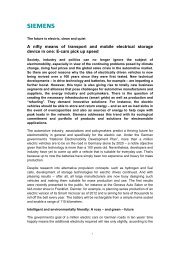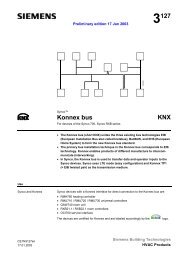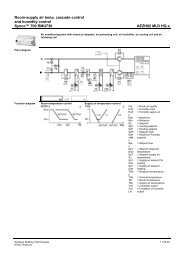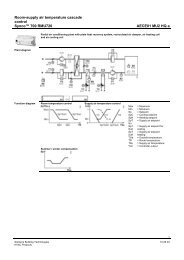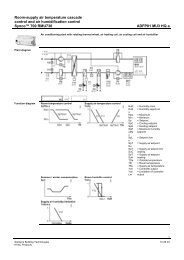Motor and Trailer Bogies for Heavy Metro Vehicles - Siemens
Motor and Trailer Bogies for Heavy Metro Vehicles - Siemens
Motor and Trailer Bogies for Heavy Metro Vehicles - Siemens
Create successful ePaper yourself
Turn your PDF publications into a flip-book with our unique Google optimized e-Paper software.
SF 30 C TFW<br />
<strong>Motor</strong> Bogie <strong>for</strong> Low Floor Tram Cars<br />
The bogie SF 30 C TFW is in service <strong>for</strong><br />
the low floor tram Combino <strong>and</strong> has<br />
been in production since 1998. It allows<br />
<strong>for</strong> a floor height of 350 mm above TOR<br />
throughout the whole length of the car.<br />
The bogie family SF 30 C was developed<br />
in 1996 <strong>and</strong> allows <strong>for</strong> a high degree of<br />
modularity as well as the car design<br />
itself. The bogies are available <strong>for</strong><br />
st<strong>and</strong>ard <strong>and</strong> meter gauge.<br />
With regards to its vertical axis, the<br />
bogie has a torsion-resistant connection<br />
to the carbody by means of two<br />
longitudinal guides. This ensures<br />
optimum aisle width between the wheel<br />
guards.<br />
The bogie is equipped with completely<br />
suspended traction drive units with self<br />
ventilated three-phase asynchronous<br />
motors. The wheels of these motors are<br />
arranged in line <strong>and</strong> speedcoupled by<br />
means of the motor gearing unit. This<br />
design gives the bogie excellent axle<br />
guidance characteristics such as selfcentering<br />
<strong>and</strong> low tendency to lateral<br />
oscillation.<br />
The traction drive units, equipped with<br />
spring-loaded brakes, are arranged at<br />
the side so that all major traction <strong>and</strong><br />
brake components can easily be<br />
reached. As a result nearly all<br />
maintenance work can usually be<br />
per<strong>for</strong>med without the need <strong>for</strong> a pit.<br />
The complete traction drive units can<br />
even be removed <strong>and</strong> installed without<br />
having to lift the vehicle or remove the<br />
bogies.<br />
The torque transmission from the<br />
traction motor to the front <strong>and</strong> rear<br />
wheel is effected by a low-noise bevel<br />
gear <strong>and</strong> two cardanic spider couplings,<br />
which are arranged at different levels.<br />
Primary suspension features rotationally<br />
symmetrical rubber-metal springs with<br />
good selfdamping characteristics<br />
ensuring longitudinally <strong>and</strong> laterally<br />
flexible wheelset guidance.<br />
Secondary suspension features steel<br />
helicoil springs, combined with<br />
additional rubber springs giving<br />
progressive spring characteristic <strong>for</strong><br />
good ride quality in all load conditions.<br />
Vertical <strong>and</strong> lateral movement is<br />
damped hydraulically.<br />
The stub axle of cast design is equipped<br />
with an earthing contact, which is<br />
accessible from the vehicle side (pit). If<br />
required each wheel can be equipped<br />
with a grounding device.<br />
The wheel diameter <strong>for</strong> both st<strong>and</strong>ard<br />
<strong>and</strong> meter gauge bogies is 600 mm<br />
(new) <strong>and</strong> 520 mm (worn). To reduce<br />
wheel squeal, noise absorber can be<br />
mounted.<br />
The bogie frame is a H-shaped<br />
combination of plates, cast <strong>and</strong> <strong>for</strong>ged<br />
parts.<br />
17




